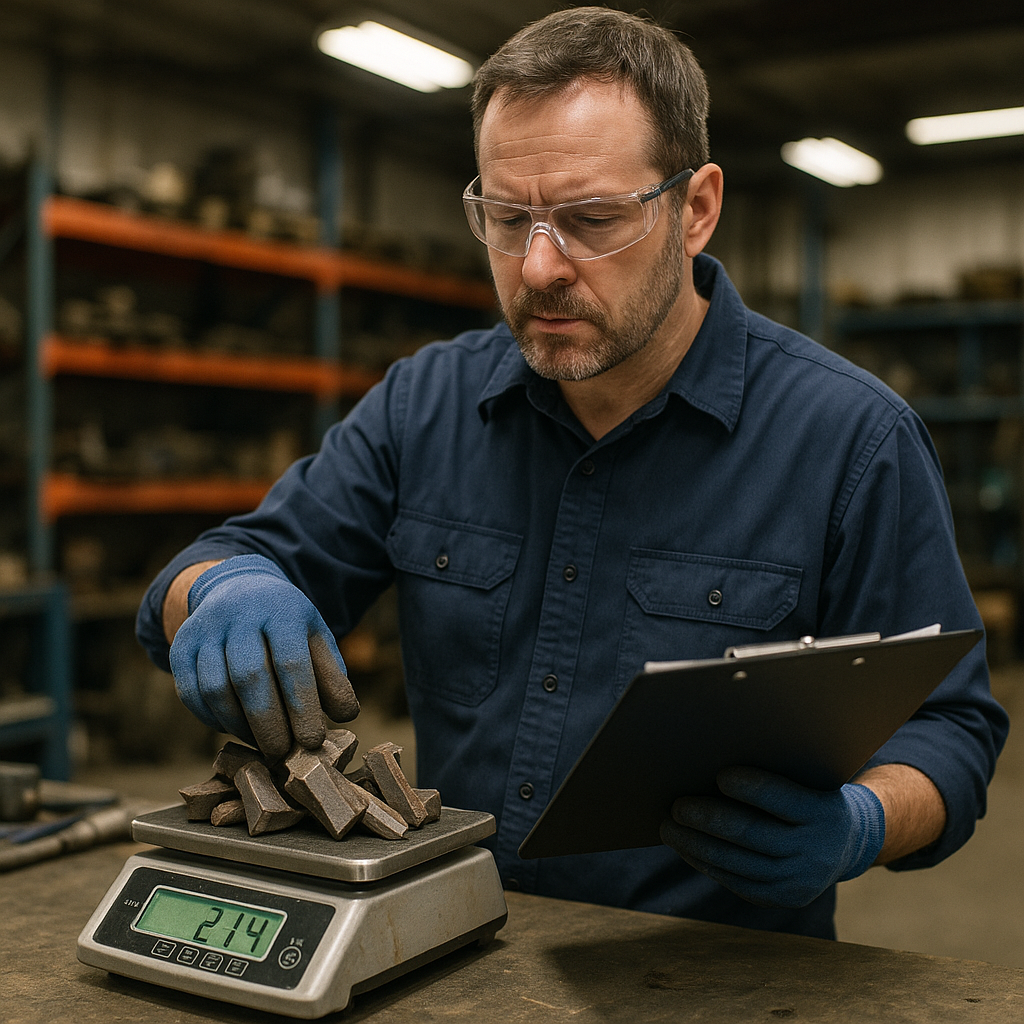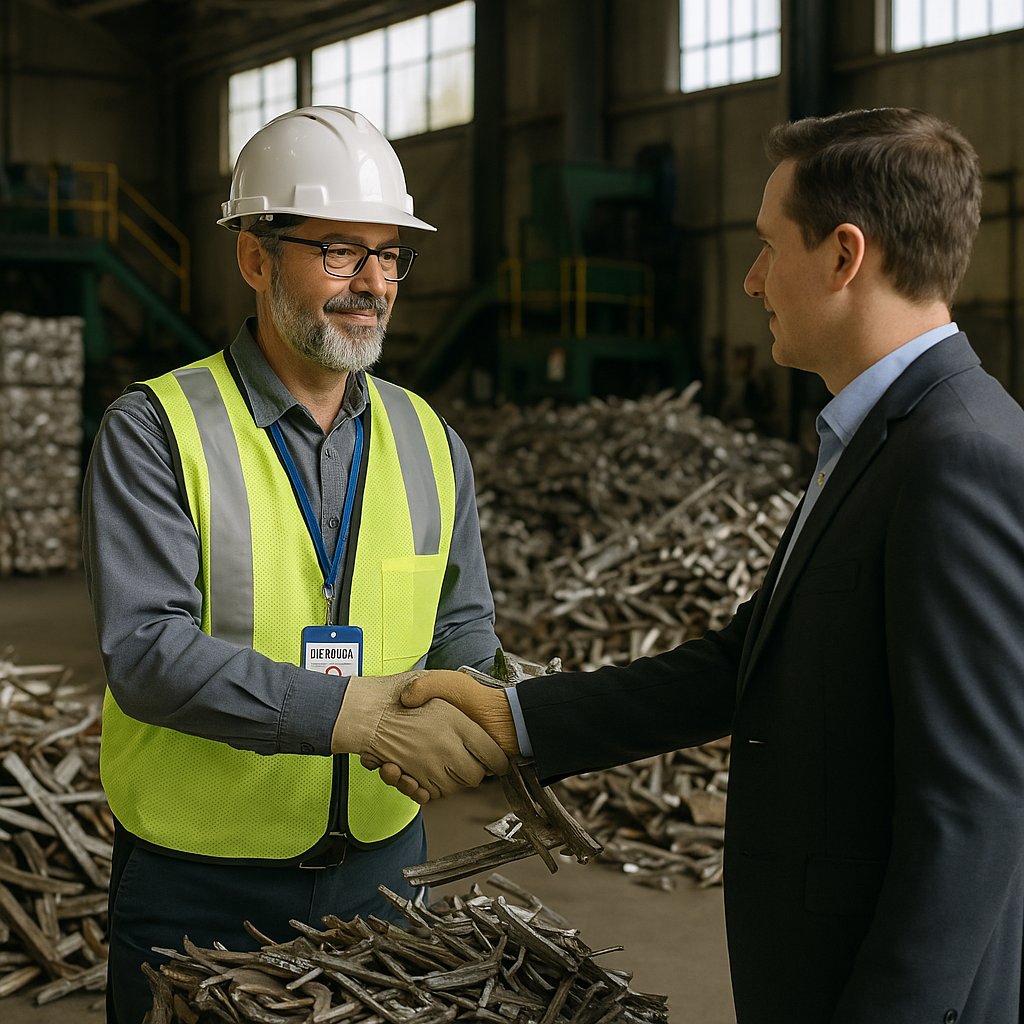5901 Botham Jean Blvd, Dallas, TX 75215
Scrap Metal Valuation in Bankruptcy Cases Explained
August 8, 2025When businesses or individuals with significant metal assets file for bankruptcy, determining the actual value of scrap metal becomes crucial to the proceedings. Scrap metal valuation in bankruptcy cases is the systematic process of assessing the fair market value of metal assets that will be liquidated to satisfy creditor claims. This appraisal forms the basis for equitable distribution of assets and directly impacts how much creditors will recover.
The valuation process requires specialized knowledge of metal markets and careful assessment methodology. Bankruptcy courts rely on these valuations to ensure the bankruptcy estate is properly valued, preventing both undervaluation that would harm creditors and overvaluation that creates unrealistic expectations. The 2024 federal bankruptcy court case involving Erath Iron & Metal highlighted this challenge when conflicting valuations emerged—one appraisal firm assessed inventory at approximately $2 million, while the company had reported values exceeding $8 million.
Accurate scrap metal valuation depends on several key factors. Current market prices form the baseline, but the actual worth varies based on metal type, quantity, quality, and purity.
What Are the Key Methods for Appraising Scrap Metal?

Accurate valuation of scrap metal assets in bankruptcy cases is essential for all stakeholders. Courts and bankruptcy trustees rely on these valuations to make fair determinations about asset disposition and creditor payments. Let’s explore the primary methodologies used by professional appraisers when determining the value of scrap metal assets.
Market Value Approach
The market value approach determines scrap metal value by comparing assets to recent sales of similar materials. This method reflects what willing buyers and sellers would agree upon in current market conditions. It’s often considered the most reliable valuation method when sufficient market data exists.
For example, if a bankruptcy estate includes 50 tons of stainless steel scrap, an appraiser would research recent sales prices of similar grade stainless steel in the regional market. They might contact several local scrap yards to obtain current buying prices or analyze industry pricing reports. This creates a realistic benchmark of what the metal would sell for under normal circumstances.
Bankruptcy courts generally prefer market valuations because they reflect real-world conditions rather than theoretical assumptions. The Third Circuit Court specifically noted in In re VFB LLC v. Campbell Soup Co. that “absent some reason to distrust it, the market price is a more reliable measure of value than the subjective estimates of expert witnesses.”
Replacement Cost Approach
The replacement cost approach calculates how much it would cost to replace the scrap metal assets with materials of similar quality and utility. This method is particularly useful when dealing with specialized alloys or rare metals where direct market comparisons may be limited.
Consider a bankruptcy case involving a specialized copper alloy used in industrial applications. An appraiser would determine the current cost of acquiring the raw materials, processing them to the appropriate specifications, and any other related expenses. This approach provides an upper boundary for valuation since few buyers would pay more than replacement cost.
While replacement cost can be valuable in specific scenarios, bankruptcy courts often view this method with caution. The approach may overvalue assets, especially in distressed situations where immediate replacement isn’t practical.
Liquidation Value Approach
The liquidation value approach determines what the scrap metal would bring in a rapid or distressed sale scenario. This method recognizes the time constraints and pressure often present in bankruptcy proceedings. There are two common sub-categories:
- Orderly liquidation value: The estimated amount realizable from selling assets over a reasonable period, typically 3-6 months.
- Forced liquidation value: The expected amount if assets must be sold immediately, often resulting in significantly lower values.
For instance, if a bankruptcy trustee needs to quickly dispose of 100 tons of mixed scrap aluminum, the liquidation value might be 30-50% below standard market rates due to the compressed timeframe and the buyer’s awareness of the seller’s urgency.
Bankruptcy courts frequently rely on liquidation values when determining adequate protection for secured creditors or evaluating Chapter 7 liquidation scenarios. As noted in the In re Scrap Metal Buyers of Tampa case, the timing and circumstances of the bankruptcy proceedings significantly impact which valuation method is most appropriate.
Multiple Method Approach
Professional appraisers rarely rely on a single valuation method. Instead, they typically use multiple approaches and assign different weights to each based on the specific case circumstances. This practice helps overcome the limitations of any single methodology and provides a more robust valuation.
Courts have consistently endorsed this approach. In In re DBSD N. Am. Inc., the court noted that experts used “a weighted average of the three traditional valuation methods” while making adjustments based on the specific facts of the case. Similarly, in In re Spansion, Inc., each party relied on weighted averages of multiple valuation methods to establish credible valuation ranges.
The specific weighting of methods depends on numerous factors, including:
- The type and quality of scrap metal involved
- Market conditions and volatility
- The purpose of the valuation (adequate protection, plan confirmation, etc.)
- The anticipated timeframe for asset disposition
- The availability and reliability of market data
Timing Considerations in Bankruptcy Valuations
The timing of scrap metal appraisals in bankruptcy cases can significantly impact the final valuation. Courts must consider when the valuation occurs relative to key bankruptcy events:
For adequate protection purposes, valuation typically focuses on potential diminution in value between the petition date and the hearing date. In determining post-petition interest for oversecured creditors under Section 506(b), courts examine whether the creditor was oversecured at relevant points during the case. Plan confirmation valuations generally focus on the value as of the confirmation date.
Ultimately, the most appropriate valuation method depends on the specific circumstances of each bankruptcy case. Courts must balance the interests of all stakeholders while ensuring that valuations accurately reflect market realities. By understanding these key appraisal methodologies, parties in bankruptcy proceedings can better advocate for fair and reasonable valuations of scrap metal assets.
How Do You Choose a Qualified Scrap Metal Appraiser?

Selecting a qualified scrap metal appraiser is crucial, as it can significantly influence the accuracy of your valuation during bankruptcy proceedings. The right professional ensures you receive a fair and defensible assessment of your metal assets.
Professional Credentials and Specialized Experience
When considering potential appraisers, prioritize those with recognized professional certifications. Look for credentials such as Accredited Senior Appraiser (ASA) or membership in professional appraisal institutes.
Industry-specific experience is equally important. The appraiser should have a proven track record in valuing scrap metal specifically, not just general property. Their experience should include bankruptcy cases, accommodating their unique requirements.
Request information about their experience with similar cases. How many scrap metal valuations have they performed in bankruptcy situations? This insight helps gauge their familiarity with your specific needs.
Market Knowledge and Technical Expertise
A qualified scrap metal appraiser must demonstrate an in-depth knowledge of current market conditions. They should understand price fluctuations for different metals and how various factors influence valuation.
Ask potential appraisers about their methods for staying current with metal prices. Do they use industry-standard resources? Are they familiar with the latest recycling technologies and how these affect metal values?
The appraiser should be able to explain different valuation methodologies. Look for professionals who utilize multiple approaches to determine value, such as market comparison, cost, and income approaches when appropriate.
Verification Checklist for Appraiser Qualifications
- Verify professional certifications and memberships in appraisal organizations
- Request and contact references from previous bankruptcy-related appraisals
- Review sample reports to assess thoroughness and clarity
- Confirm knowledge of local scrap metal markets and price trends
- Verify experience with court testimony if your case might require it
- Check for proper insurance and business credentials
A qualified appraiser should readily provide this information. Be wary of those who are hesitant to share credentials or references.
Communication and Reporting Standards
Effective communication is essential for a successful appraisal process. The appraiser should clearly explain their methodology and findings in terms you can understand.
Review their reporting standards carefully. A proper scrap metal appraisal report should include detailed descriptions of the metals assessed, current market conditions, valuation methods used, and clear value conclusions.
The report must be comprehensive enough to withstand scrutiny in court. It should follow USPAP (Uniform Standards of Professional Appraisal Practice) guidelines and include sufficient supporting documentation.
Key Questions to Ask During Interviews
When interviewing potential appraisers, ask these targeted questions to assess their qualifications:
- What specific experience do you have with scrap metal valuation in bankruptcy cases?
- How do you stay current with metal market prices and trends?
- What valuation methods will you use for my specific situation?
- Can you provide a sample report similar to what I would receive?
- What information will you need from me to complete an accurate appraisal?
- How long will the appraisal process take?
- Have your appraisals been challenged in court? What was the outcome?
Their answers will reveal their expertise level and whether their approach aligns with your needs.
Local Market Understanding
An appraiser with knowledge of regional scrap metal markets provides additional value. Local expertise ensures they understand specific factors that might affect metal values in your area.
Regional economic conditions can significantly impact scrap metal prices. An appraiser familiar with your local market will account for these variations in their assessment.
Ask about their experience with similar materials in your region. Have they worked with local recycling facilities? Do they understand regional pricing differences?
| Attribute | Detail |
|---|---|
| Professional Credentials | Look for certifications such as Accredited Senior Appraiser (ASA) or memberships in professional appraisal institutes. |
| Industry-Specific Experience | Proven track record in scrap metal valuation, particularly in bankruptcy cases. |
| Market Knowledge | Understanding of current market conditions and price fluctuations for different metals. |
| Technical Expertise | Ability to explain and use different valuation methodologies, such as market comparison, cost, and income approaches. |
| Transparency | Clear reporting standards, comprehensive reports following USPAP guidelines, and open communication about methodology and findings. |
Transparency and Ethical Standards
Choose an appraiser who demonstrates clear ethical standards and transparency. They should be forthcoming about their process, fees, and any potential conflicts of interest.
The appraiser should maintain independence and objectivity throughout the valuation process. Be wary of professionals who might have relationships with potential buyers of your scrap metal.
A qualified appraiser prioritizes accurate valuation over expedient results. They should be willing to take the time necessary to conduct a thorough assessment rather than rushing to a conclusion.
What Factors Affect Scrap Metal Value in Bankruptcy Cases?

The value of scrap metal during bankruptcy proceedings fluctuates based on several key factors. Understanding these elements helps creditors and trustees maximize asset recovery in often time-sensitive situations.
Metal Type and Quality
Different metals command vastly different prices in the recycling market. Copper, aluminum, brass, and stainless steel typically fetch higher values than iron or mixed metals. The purity of the metal also significantly impacts its worth.
Quality assessment becomes crucial during bankruptcy liquidations. Clean, sorted metals will consistently yield better returns than contaminated or mixed materials. Bankruptcy estates with high-grade copper wiring or clean aluminum extrusions will realize substantially higher values than those with rusted or painted scrap.
Market Price Volatility
Scrap metal prices fluctuate daily based on global commodity markets. These prices are influenced by international trade policies, production outputs, and economic indicators. During bankruptcy proceedings, timing can dramatically affect recovery values.
A bankruptcy trustee forced to liquidate assets quickly may encounter unfavorable market conditions. This timing constraint often results in less-than-optimal returns compared to scenarios where liquidation can be strategically timed for favorable market conditions.
Quantity and Scale Considerations
The volume of available scrap metal directly influences valuation. Larger quantities typically command better per-unit prices due to economies of scale in processing and transportation. This provides a distinct advantage for industrial bankruptcies compared to smaller business liquidations.
Many scrap metal buyers offer tiered pricing structures. A bankruptcy involving tons of uniform metal will attract competitive bids from major recyclers. Smaller quantities may limit the pool of interested buyers to local yards offering lower rates.
Location and Transportation Logistics
Geographic location plays a critical role in determining net scrap metal value. Proximity to recycling facilities, ports, or major transportation hubs can significantly impact the bottom line. Transportation costs can quickly erode profits for remote bankruptcy estates.
Regional market differences also affect pricing. Urban areas with multiple competing recyclers typically offer better rates than rural locations with limited options. The cost of moving heavy materials across significant distances can sometimes exceed the value difference between local and distant buyers.
Processing Requirements
The condition of scrap metal and any required processing directly impacts valuation. Materials requiring extensive dismantling, sorting, or decontamination will command lower prices. This factor becomes especially relevant in bankruptcy cases involving complex industrial equipment or facilities.
Labor costs associated with preparing scrap for recycling must be factored into valuation assessments. Bankruptcy estates containing ready-to-recycle materials will realize higher returns than those requiring significant preparation work.
Bankruptcy-Specific Constraints
Time pressures unique to bankruptcy proceedings often force liquidation on compressed timelines. This urgency typically results in accepting lower offers to achieve quick resolution. Court-mandated deadlines rarely align with optimal market conditions.
The administrative costs of managing and securing scrap metal assets during bankruptcy also affect net recovery. Extended holding periods incur ongoing expenses for security, insurance, and storage that must be weighed against potential price improvements.
| Factor | Description |
|---|---|
| Metal Type and Quality | Different metals have different values; higher purity metals fetch more. |
| Market Price Volatility | Prices fluctuate based on global commodity markets; timing of sale is crucial. |
| Quantity and Scale | Larger quantities often receive better per-unit prices due to economies of scale. |
| Location and Transportation | Proximity to recycling facilities and transportation logistics influence value. |
| Processing Requirements | Metals that require more processing or decontamination have reduced value. |
| Bankruptcy-Specific Constraints | Urgency can necessitate quicker, lower-value sales; administrative costs also impact recovery. |
Economic conditions and market demand exert an overarching influence on all bankruptcy liquidations. During economic downturns, reduced manufacturing activity typically suppresses scrap metal prices. This unfortunate timing often coincides with increased bankruptcy filings, creating a challenging environment for maximizing asset recovery.
Conclusion: Ensuring Accurate Scrap Metal Valuation in Bankruptcy
Accurate scrap metal valuation is crucial in bankruptcy proceedings. When stakeholders use proper valuation methods, they protect the interests of creditors, debtors, and the court. The timing of valuation is critical, with courts typically determining value at the time of filing or transfer, depending on the specific bankruptcy context.
Reliable valuations require qualified appraisers who understand both scrap metal markets and bankruptcy requirements. These professionals apply appropriate methodologies—whether fair market value for reorganizing entities or liquidation value for those close to insolvency. This approach maximizes recovery for all parties while providing the transparency courts demand.
For assistance with scrap metal recycling needs or questions about valuation in challenging situations, contact Okon Recycling at 214-717-4083.
